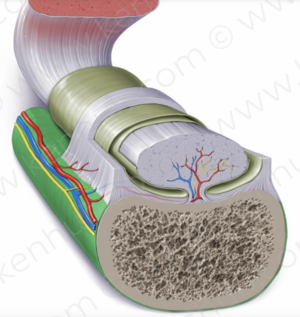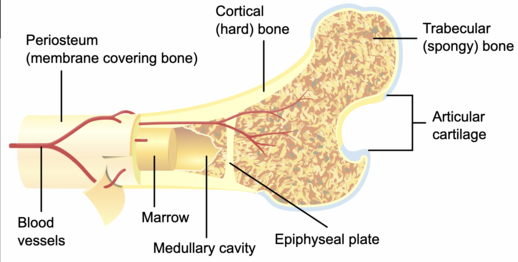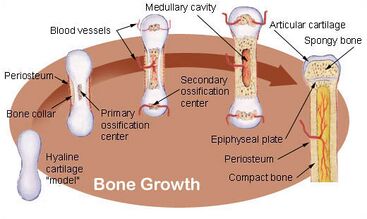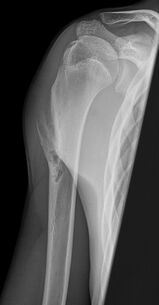Periosteum: Difference between revisions
(Created page with "{{subst:New Page}}") |
Oyemi Sillo (talk | contribs) (Undo revision 329455 by Oyemi Sillo (talk)) Tag: Undo |
||
| (15 intermediate revisions by 3 users not shown) | |||
| Line 1: | Line 1: | ||
<div class="editorbox"> | <div class="editorbox"> | ||
'''Original Editor '''- [[User: | '''Original Editor '''- [[User:Lucinda hampton|Lucinda hampton]] | ||
'''Top Contributors''' - {{Special:Contributors/{{FULLPAGENAME}}}} | '''Top Contributors''' - {{Special:Contributors/{{FULLPAGENAME}}}} | ||
</div> | </div> | ||
== Introduction == | == Introduction == | ||
[[File:Periosteum (green).png|thumb|Periosteum (vivid green)]]<ref>Periosteum - © Kenhub<nowiki/>https://www.kenhub.com/en/library/anatomy/periosteum</ref> | |||
The periosteum is a membranous tissue that covers the surfaces of [[Bone|bones.]] It is an intricate structure composed of an outer fibrous layer that gives structural integrity and an inner cambium layer that possesses osteogenic potential. During growth and development it aides in bone elongation and modelling, and when a bone is [[Fracture|fractured]], participates in its recovery. It is not present in [[sesamoid]] bones and the intra-articular ends of bones.<ref>Dwek JR. The periosteum: what is it, where is it, and what mimics it in its absence?. Skeletal radiology. 2010 Apr;39(4):319-23. Available:https://www.ncbi.nlm.nih.gov/pmc/articles/PMC2826636/ (accessed 8.9.2022)</ref> | |||
# The periosteum separates the bone from surrounding structures. It contains small blood vessels that provide nourishment to the outer cortex of bones. | |||
# The periosteum has a plentiful supply of sensory nerves and is exceedingly sensitive to pain. This network of nerve fibers transmits messages throughout the body. It is the main structure responsible for the acute pain experienced during fractures.<ref>Kenhub Periosteum Available:https://www.kenhub.com/en/library/anatomy/periosteum (accessed 9.9.2022)</ref> | |||
== | == Outer Fibrous Layer == | ||
[[File:Periosteum.png|right|frameless|518x518px|alt=]] | |||
The outer layer of the periosteum is mostly made of elastic fibrous material, such as [[Collagen|collagen.]] It also contains blood vessels and nerves. | |||
# | The blood vessels of the periosteum contribute to the blood supply of the body’s bones. They can pass into the dense and compact layer of bone tissue below, called the bone cortex. | ||
# | |||
The nerves of the periosteum register pain when the tissue is injured or damaged. Some of the nerves of the periosteum travel alongside the blood vessels into the bone, although many remain in the outer layer of the periosteum.<ref name=":0">Healthline [https://www.healthline.com/health/periosteum#Periosteum-function-and-anatomy What is the periosteum] Available:https://www.healthline.com/health/periosteum#Periosteum-function-and-anatomy (accessed 9.9.2022)</ref> | |||
== Inner Cambrium Layer == | |||
[[File:Bone growth.jpeg|right|frameless|367x367px]] | |||
The inner cellular layer of the periosteum (described as the inner cambium layer by some authors) is made up of osteoprogenitor cells (fibroblast-like cells); it is also known as the osteogenetic layer. This layer contains osteoblasts in young developing bones and in adult bones, osteoblasts may be absent, but appear whenever required (e.g., fracture healing). The rate of regeneration for healing will be slower than in a child. This layer begins thinning in childhood and continues through to do so in adulthood. Often the inner layer becomes so thin that it’s indistinguishable from the outer layer of the periosteum.<ref>Nahian A, Chauhan PR. Histology, Periosteum and Endosteum. InStatPearls [Internet] 2022 May 8. StatPearls Publishing.Available:https://www.ncbi.nlm.nih.gov/books/NBK557584/ (accessed 9.9.2022)</ref> | |||
== Periosteal Conditions == | |||
# [[File:Periosteal Chondromas.jpeg|thumb|305x305px|Periosteal Chondroma]]Periostitis is an inflammation of the periosteum, and is caused by overuse or repetitive stress to muscles and connective tissue. It is often present with [[Shin-splints|shin splints]], a painful condition that tends to affect [[Bone Stress Injuries|runners]] and dancers.<ref name=":0" /> | |||
# Periosteal Chondromas are rare, benign, chondrogenic tumors. Occur on the surface of long bones, most frequently the proximal humerus. Patients are usually between the ages of 10 and 20 years of age with regional pain secondary to irritation of overlying tendons. Diagnosis is made on Xray. Treatment is usually observation. Marginal surgical excision of the lesion, including the underlying cortex, is indicated in patients with severe and progressive pain.<ref>Orthobullets Periosteal Chondromas Available;https://www.orthobullets.com/pathology/8019/periosteal-chondromas (accessed 9.9.2022)</ref> | |||
== References == | == References == | ||
<references /> | <references /> | ||
[[Category:Anatomy]] | |||
[[Category:Physiology]] | |||
[[Category:Bone - Conditions]] | |||
Latest revision as of 18:54, 31 March 2023
Original Editor - Lucinda hampton
Top Contributors - Lucinda hampton, Oyemi Sillo and Vidya Acharya
Introduction[edit | edit source]
The periosteum is a membranous tissue that covers the surfaces of bones. It is an intricate structure composed of an outer fibrous layer that gives structural integrity and an inner cambium layer that possesses osteogenic potential. During growth and development it aides in bone elongation and modelling, and when a bone is fractured, participates in its recovery. It is not present in sesamoid bones and the intra-articular ends of bones.[2]
- The periosteum separates the bone from surrounding structures. It contains small blood vessels that provide nourishment to the outer cortex of bones.
- The periosteum has a plentiful supply of sensory nerves and is exceedingly sensitive to pain. This network of nerve fibers transmits messages throughout the body. It is the main structure responsible for the acute pain experienced during fractures.[3]
Outer Fibrous Layer[edit | edit source]
The outer layer of the periosteum is mostly made of elastic fibrous material, such as collagen. It also contains blood vessels and nerves.
The blood vessels of the periosteum contribute to the blood supply of the body’s bones. They can pass into the dense and compact layer of bone tissue below, called the bone cortex.
The nerves of the periosteum register pain when the tissue is injured or damaged. Some of the nerves of the periosteum travel alongside the blood vessels into the bone, although many remain in the outer layer of the periosteum.[4]
Inner Cambrium Layer[edit | edit source]
The inner cellular layer of the periosteum (described as the inner cambium layer by some authors) is made up of osteoprogenitor cells (fibroblast-like cells); it is also known as the osteogenetic layer. This layer contains osteoblasts in young developing bones and in adult bones, osteoblasts may be absent, but appear whenever required (e.g., fracture healing). The rate of regeneration for healing will be slower than in a child. This layer begins thinning in childhood and continues through to do so in adulthood. Often the inner layer becomes so thin that it’s indistinguishable from the outer layer of the periosteum.[5]
Periosteal Conditions[edit | edit source]
- Periostitis is an inflammation of the periosteum, and is caused by overuse or repetitive stress to muscles and connective tissue. It is often present with shin splints, a painful condition that tends to affect runners and dancers.[4]
- Periosteal Chondromas are rare, benign, chondrogenic tumors. Occur on the surface of long bones, most frequently the proximal humerus. Patients are usually between the ages of 10 and 20 years of age with regional pain secondary to irritation of overlying tendons. Diagnosis is made on Xray. Treatment is usually observation. Marginal surgical excision of the lesion, including the underlying cortex, is indicated in patients with severe and progressive pain.[6]
References[edit | edit source]
- ↑ Periosteum - © Kenhubhttps://www.kenhub.com/en/library/anatomy/periosteum
- ↑ Dwek JR. The periosteum: what is it, where is it, and what mimics it in its absence?. Skeletal radiology. 2010 Apr;39(4):319-23. Available:https://www.ncbi.nlm.nih.gov/pmc/articles/PMC2826636/ (accessed 8.9.2022)
- ↑ Kenhub Periosteum Available:https://www.kenhub.com/en/library/anatomy/periosteum (accessed 9.9.2022)
- ↑ 4.0 4.1 Healthline What is the periosteum Available:https://www.healthline.com/health/periosteum#Periosteum-function-and-anatomy (accessed 9.9.2022)
- ↑ Nahian A, Chauhan PR. Histology, Periosteum and Endosteum. InStatPearls [Internet] 2022 May 8. StatPearls Publishing.Available:https://www.ncbi.nlm.nih.gov/books/NBK557584/ (accessed 9.9.2022)
- ↑ Orthobullets Periosteal Chondromas Available;https://www.orthobullets.com/pathology/8019/periosteal-chondromas (accessed 9.9.2022)










